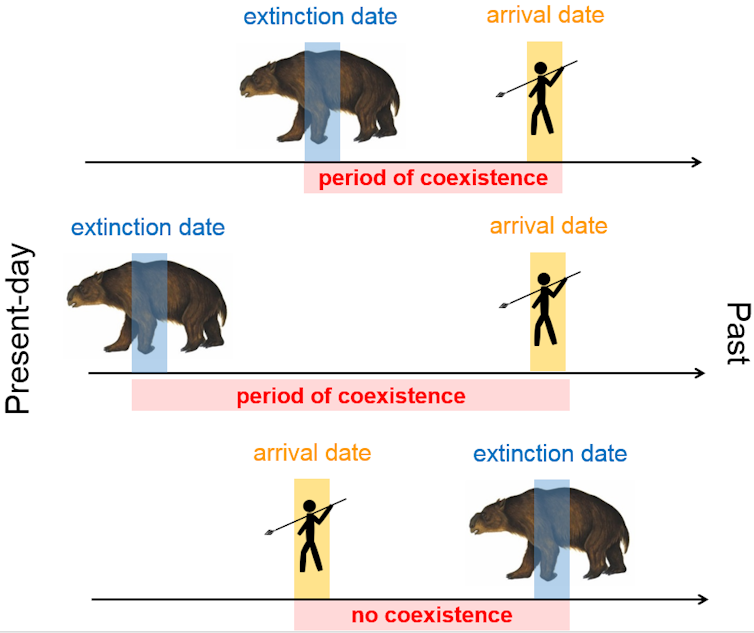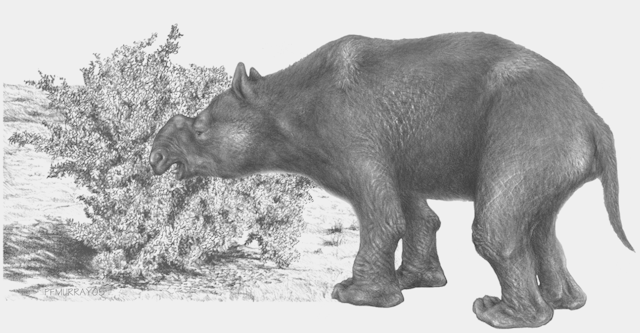During the period from 60,000 to 800 years ago, the world lost most of its big animals, or “megafauna”. The cause of this mass extinction is controversial, nowhere more so than in Australia.
Australia’s megafauna consisted of an amazing variety of bizarre creatures including giant wallabies and kangaroos; great wombat-like beasts such as Diprotodon, Zygomaturus and Palorchestes; and colossal birds and reptiles.
Did we lose these animals because of drastic climate changes? Or was it overhunting by ancient Aboriginal people, or indirect effects of people changing the vegetation with fire? Or perhaps some combination of these?
Our new study, featuring the most accurate dates ever compiled for these extinctions, finds that most species went extinct just a few millennia after humans first appeared in Australia, meaning that the arrival of humans was the decisive event in the megafauna’s demise.
Finding the cause
To decide between the possible causes of climate change or human impact we need to compare the timing of extinction with human arrival and climate change. The graphic below shows three possible scenarios that could arise once the dates of these events have been established reliably.

In the first scenario, most animal extinctions occur soon after humans arrive. If there is no evidence for any large changes in climate at or immediately before this time, we might therefore conclude that humans were responsible.
In the second case, the animals go extinct after a period of coexistence with humans. The longer the coexistence, the more likely that other drivers like climate change could have contributed to the animals’ demise. Alternatively, the slow pace of the eventual extinction could reflect gradual growth of human populations to sizes at which they begin to have impacts. Again, the key is whether the climate changed remarkably during this interval of coexistence.
The final possibility is that the extinctions preceded the arrival of humans, who therefore had nothing to do with it. If the climate changed noticeably when the animals went extinct, we can be confident that climate change was the main cause.
This seems straightforward, but the problem is getting good data to reconstruct these timelines. Dating techniques often give us highly uncertain (or even dodgy) estimates of the ages of fossils and other ancient material. And because of poor preservation in Australia’s harsh climate, we have fewer fossils than in other parts of the world.
Building a reliable timeline
In our study, published in Nature Communications, we and our colleagues reconstructed the first reliable extinction timelines for 16 megafauna groups in Australia. We then matched these dates against the timing of humans’ arrival in Australia, and against six different measures of prehistoric climate.
Our first challenge was the variable quality of fossil dates. Some published dates are either too uncertain to be useful, or are based on questionable or outdated techniques. We previously developed a system to assess the reliability of fossil dates, and we applied this to all published dates on Australia’s megafauna.
The next problem was using the fossil dates to work out when species went extinct. Unfortunately, the youngest fossil almost never indicates the true timing of extinction. Fossilisation is so rare that it’s practically impossible that the last individual of a species will wind up as a fossil. Extinction could be many thousands of years later than the date of the youngest fossil.
Several mathematical techniques can estimate the window of true extinction from a series of dates. We used these methods to infer extinction timing for those megafauna with enough reliable dates for analysis. We also used the same methods to estimate the time of human arrival from archaeological dates.
Last, we aligned these timelines with several climate measures going back to 120,000 years ago – temperature and precipitation variations, ice core data indicating relative temperature, El Niño intensity, and the speed at which a species would need to migrate to track the shifting climate conditions. We then checked to see whether large changes in these climate measures happened around the same time as any of the extinction events.
The result was remarkably clear. We found a peak of extinctions around 42,000 years ago – around 13,000 years after the arrival of humans. There was no correlation between extinction and any of the climate indicators (whether or not we allowed for time lags between climate changes and extinction).
This suggests that if climate did have a role, it was only minor or localised and cannot explain the broad pattern of extinctions over the whole continent.
Extinctions began when humans first arrived, but the peak in extinctions came 13,000 years later. This is an intriguing delay. On one hand, it clearly allows plenty of time for people to have become widespread and affect the continental ecosystem; on the other, it suggests that human impacts emerged only gradually. This may show that human populations in Australia grew very slowly at first, as suggested by other analyses of the archaeological record.

Is it that simple?
So it looks like humans did it, but we should note that our findings apply at the scale of the entire continent of Australia. Although our data are the best currently available, they do not rule out effects of climate on extinctions on a smaller regional scale. We still have a lot to learn about the details of the disappearance of our megafauna.

